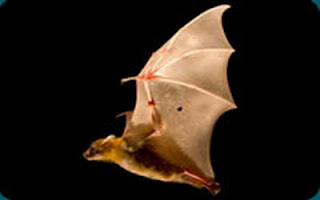
Keep your ears peeled
What do bats, submarines and doctors have in common? They all rely on sound to ‘see’ better.
Most of the time, our eyes do a pretty good job of telling us about our surroundings. Seeing in the dark or in murky water is much trickier, but bats and dolphins have found a way around this problem, relying on sound waves to find their bearings and even to catch prey. The secret behind this ability lies in an everyday phenomenon - the echo.
All about echoes
You’re in a cave. Shout. A moment later you hear your voice’s ghostly twin - an echo. This happens because the sound waves produced by your vocal cords travel through the air, bounce off the cave walls and are picked up again by your ears.
Sound travels relatively slowly, about 343 metres per second in air, which is why there’s a slight delay before you hear the echo. But this delay is what allows bats to make use of echos.
Bats have vocal cords and ears that are fine-tuned for producing and hearing very high frequencies of sound, known as ultrasound. They emit high-pitched ‘chirps’, which are inaudible to humans, and then listen out for the resulting echos. Keeping track of how long it takes for each cry to be reflected back enables them to work out how far away an object is.
Other characteristics of the echo can also give bats an idea of the object’s size and the direction it’s moving in. By piecing together this information, they can build up an accurate image of their surroundings, and spot tasty insects in the dark.
Ultrasound waves enable bats to get a clear picture of their environment as they don’t spread out around obstacles as much as lower frequency sounds like the human voice. Imagine trying to find your way around a dark cave just by listening to the echos of your shouts.
Sound in medicine
It wasn’t long before scientists caught on to this nifty idea and adapted it to enable submarines to locate their targets and to give doctors a peek into their patients’ bodies.
Ultrasound imaging has been used in medicine for over 50 years. Specialised equipment directs pulses of high frequency sound waves into the body and, as these waves meet different layers of tissue, they are reflected back and analysed.
Millions of pulses and echoes are produced and received each second, providing information which is then processed to create an image on screen. Ultrasound scans are commonly used to check on unborn babies as well as muscles and internal organs including the heart, liver and kidneys, without harming the patient.
The applications of ultrasound don’t end there. Adapting the frequency and intensity of the waves makes them suitable for a multitude of uses, including cleaning teeth, locating oil reservoirs, destroying cancerous tumours and killing bacteria in water.
With all that high pitched racket going on, we should probably be grateful that we can’t hear ultrasound.
www.physics.org![]()
When Electrons Go Ballistic
1 day ago











No comments:
Post a Comment